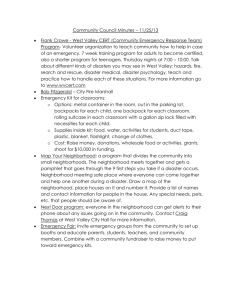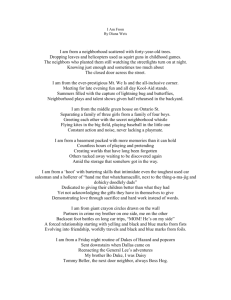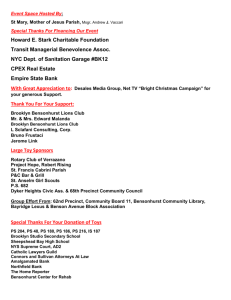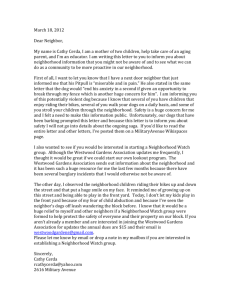occurred neighborhood
advertisement
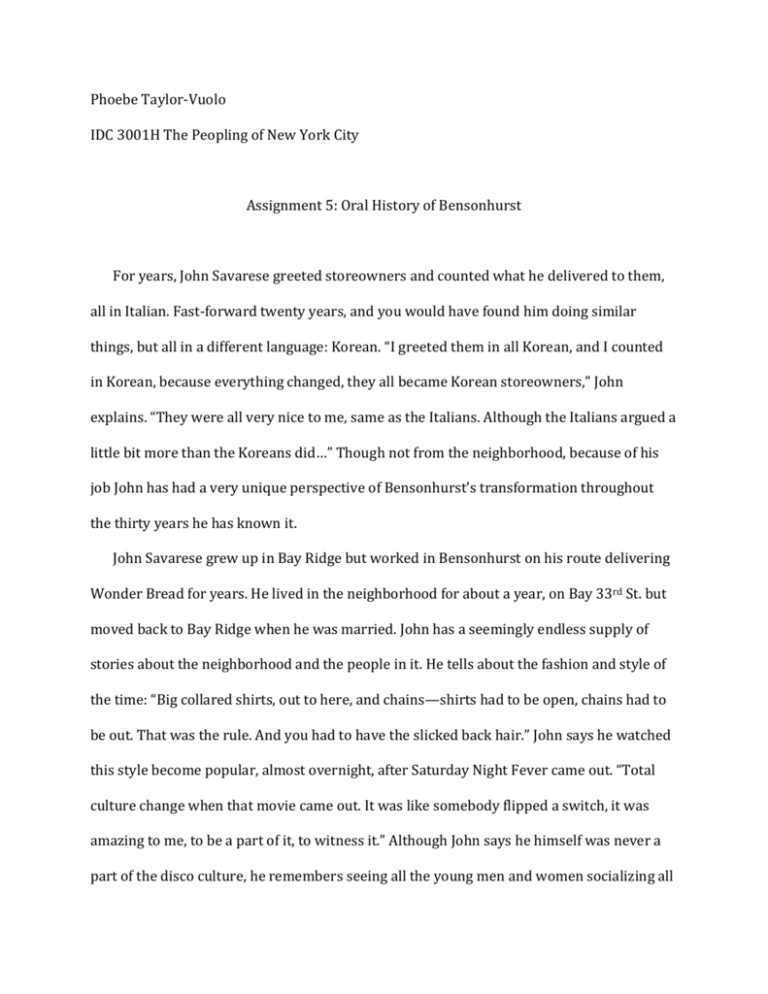
Phoebe Taylor-Vuolo IDC 3001H The Peopling of New York City Assignment 5: Oral History of Bensonhurst For years, John Savarese greeted storeowners and counted what he delivered to them, all in Italian. Fast-forward twenty years, and you would have found him doing similar things, but all in a different language: Korean. “I greeted them in all Korean, and I counted in Korean, because everything changed, they all became Korean storeowners,” John explains. “They were all very nice to me, same as the Italians. Although the Italians argued a little bit more than the Koreans did…” Though not from the neighborhood, because of his job John has had a very unique perspective of Bensonhurst’s transformation throughout the thirty years he has known it. John Savarese grew up in Bay Ridge but worked in Bensonhurst on his route delivering Wonder Bread for years. He lived in the neighborhood for about a year, on Bay 33rd St. but moved back to Bay Ridge when he was married. John has a seemingly endless supply of stories about the neighborhood and the people in it. He tells about the fashion and style of the time: “Big collared shirts, out to here, and chains—shirts had to be open, chains had to be out. That was the rule. And you had to have the slicked back hair.” John says he watched this style become popular, almost overnight, after Saturday Night Fever came out. “Total culture change when that movie came out. It was like somebody flipped a switch, it was amazing to me, to be a part of it, to witness it.” Although John says he himself was never a part of the disco culture, he remembers seeing all the young men and women socializing all along 86th street, car windows down, playing disco music and honking their horns—which apparently either played the theme tune of The Godfather or Beegees music. He tells about the parades that would come down 18th Ave, like the Italian American Parade, and the Italian food in the area that he loved, like at John’s Deli, which had “the best food there ever was.” John also says his home neighborhood, Bay Ridge, was different than Bensonhurst in that it was quieter, and much less predominantly Italian, with Irish, Norwegian, and German populations as well. John also tells about another part of Bensonhurst’s culture: the mafia presence. He seems to be very knowledgeable about the history of the mafia in Bensonhurst, and told me about John Gotti, former “head of the mafia in New York City”, who he says he actually saw once at a restaurant on 86th and 17th avenue, and “Sammy the Bull” (Sammy Gravano), the former underboss who ultimately helped to bring down Gotti himself. John has read Sammy the Bull’s book, and explained that many mafia members of the time “turned and wore wires,” because of the changing culture of the mafia and the values of John Gotti himself. “Because most mafia guys [before] wanted to be quiet, you know, they lived in very small houses, you never knew who they were, but [Gotti] wanted the fame and the fortune. And that comes with a price.” Remembering the mafia’s once significant presence in Bensonhurst, John tells about the bakery two doors down that was burned down/blown up twice because the owner refused to pay his “protection money”—“He didn’t pay it again, they blew it up again.” He tells about another bakery whose owner was told to sell a particular type of Italian bread, and threatened the if she didn’t have the Italian bread in the store on Monday morning, her store would be burned down. The storeowner ended up having a “sit-down” with the “local mafia guys, to work out a negotiation.” They agreed that she would sell both Italian breads in the store, starting Monday. “And that’s how the whole neighborhood back then was.” John remembers car bombings in the area, and the “Mafia Wars,” a particularly violent time in the neighborhood’s history. He remembers one man who, after being shot outside his friend John’s deli at Bath Avenue and 15th avenue, stumbled into the deli, then crawled out and died on the sidewalk, on the cellar grating. John had his own close call once: witnessing a shootout between two cars right in front of him as he left a store. “I was coming out of the store and a woman was coming out and I had to grab her and push her, cause she wanted to see what was going on, and I pushed her back, inside the entryway to the store and we just kind of ducked, trying not to get shot.” John says that despite all of this, he never felt unsafe in Bensonhurst. As long as he kept his “nose clean” and his “mouth shut,” making sure to never insult anybody (because, he says, you never knew who was related to whom) he never felt unsafe. “I had nothing to do with any of it, and I didn’t want to do with any of it, just stay away. I never felt unsafe. Although, well, you know, when you’re in the middle of a gunfight, you kind of say ‘hmm, maybe this neighborhood’s not so safe anymore.’ But, they weren’t shooting me, and I wanted to keep it that way.” John makes a point of explaining that the mafia wasn’t all there was to the neighborhood, but just an interesting part of it. “Those were just the things I saw, that were interesting, but it wasn’t what the whole neighborhood was about. It was just a lot of nice people. And I liked them. “ John’s favorite thing about the neighborhood was knowing all the people who lived in it, who he says were very kind to him, and almost became family to him. He watched generations of families grow up in the neighborhood, telling about the daughter of the owner of John’s deli, who he watched grow up and eventually work the register at the deli, ten or fifteen years later. He says that people in the neighborhood knew him, nicknaming him “Johnny Wonder.” They would wave at him as he drove through on his delivery route, knowing who he was by the truck, “and I’d honk the horn, wave to everybody.” He says everyone knew him and he knew everyone back then—although it seems as though he still might know his share of people in the neighborhood: he stops to say hello to people who come into the Dunkin Donuts we’re in several times just during our interview, “Hey how you doing? How are you? How’s your husband, he’s all right? Good, good. Tell him John, tell him I said hello, all right?” While we sit in Dunkin Donuts, John points across the street, explaining how drastically this block has changed, representative of changes that seem to have occurred all over the neighborhood. What is now a Chinese supermarket was an Italian furniture store for decades. Verrazano Fish, down the street, is closing, which he says is because the new Chinese members of the community tend to only shop at Chinese fish stores, and there aren’t enough Italians left in the neighborhood to keep the Italian fish store from closing. He says the block even smells differently than it used to. And John’s Deli, which John says had the best Italian food, is now a Chinese restaurant instead. Many Italians have left the neighborhood, moving to New Jersey and Staten Island instead. But he does say that many Italians return to the neighborhood for holiday shopping. For example, every year customers leave their homes in New Jersey or sometimes Pennsylvania to travel to Villabate, an Italian bakery on 18th avenue and 70th St., buying pastries and bread for the holidays. When asked whether he thinks the changes in Bensonhurst are for the better or for the worse, John offers valuable insight: it’s not better or worse, it’s just different. He says better understood the neighborhood the way that it was before, because he understood the culture. An example of this is the food: “The food, I knew and I understood. Good food…You know, you’d go in John’s you’d get baked ziti and lasagna, I knew what that was, I knew it was the best there was,” he explains. “The chickens in the window might be great food, I don’t know, I just never had it.” He says that the new, mainly Chinese, community in the neighborhood, isn’t “bad” in any way, but that he just doesn’t know it the way he knew the Italian community. If John were still working in the neighborhood, perhaps he would be going in and out of Chinese supermarkets, and eventually know everything about those storeowners too. He might even learn a bit of Chinese, the way that he learned Korean years before when the neighborhood had just started to change. John imagines the future Bensonhurst being much like Sunset Park, which used to be populated primarily by Norwegians and Germans, and now is mostly populated by Chinese immigrants. “So [Bensonhurst will] probably look like that in the future, just a different wave of immigrants taking over a neighborhood. It’s just, that’s what New York is. A different wave of immigrants.” I originally hadn’t even planned on interviewing John Savarese, who is actually Kevin’s dad, but while we were waiting to conduct another interview, he started talking about the neighborhood and we realized that, given all the information and stories he has, he would be a great person to talk to about Bensonhurst. I can’t thank Kevin and John enough, especially considering it was such a spontaneous decision to do the interview in the first place. John was friendly and open, and has some great stories as well as some real insight into the changes that have taken place in the neighborhood he worked in for so long. Because I hadn’t planned on interviewing John that day, I didn’t have any prepared questions for him, so perhaps if I were doing it again, I would come with some questions I had thought about beforehand. At the same time, I think that the spontaneous, informal nature of the interview made the conversation that much more interesting and meaningful. The questions were definitely more on the side of open ended, and the interview felt more like a normal conversation, which I actually liked a lot. Kevin was invaluable, especially because he already clearly knows a lot about his father’s experiences in the neighborhood and could ask significant and intelligent follow up questions that I never would have thought of. In general, it occurred to me that it might have been interesting for us as a group to interview a member of the Chinese community in Bensonhurst, someone who had moved to Bensonhurst, either from somewhere like Sunset Park or Chinatown, or from China, because I think that it might have given us a wider perspective and a better understanding of the different sides of the changes in the neighborhood. However, it was fascinating and important to learn about the way that Bensonhurst used to be, and hear about the transformation the neighborhood has experienced, from a person who has known it for such an extended amount of time.



